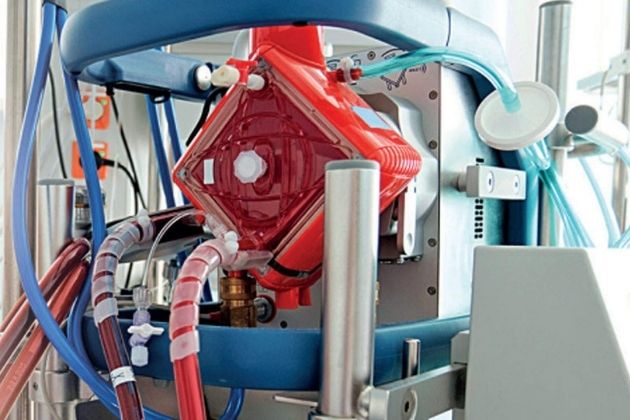

Metadata: Extracorporeal Membrane Oxygenation (ECMO) is a medical procedure recommended as a last resort for critically ill patients who need lung and heart support. ECMO takes off the load of the heart and the lungs to not only provide oxygen to all parts of the body but provide enough time for the heart and the lungs to heal.
The fullform of ECMO is Extracorporeal Membrane Oxygenation. ECMO machine is like the heart-lung by-pass machine used in open-heart surgery. It oxygenates a patient’s blood outside the body, allowing the heart and lungs to rest. When you are connected to an ECMO machine, blood flows through the tubing to an artificial lung in the machine which adds oxygen and takes out carbon dioxide. Then the blood is warmed to your body temperature and pumped back into your body. This process allows the blood to ‘bypass’ the heart and lungs, allowing these organs to rest and heal.
ECMO is used in critical care conditions, where your heart and lungs require for healing. It may be used in care for COVID-19, ARDS and other infections.
This is one of the solutions employed in the critical care unit of hospitals to assist the healing of the heart and lungs. It is therefore used for extremely ill COVID-19 patients.
It is necessary to understand that ECMO does not cure or treat a disease but only assists your body temporarily by allowing the heart and the lungs to rest. Certain conditions that require ECMO are:
With the ongoing second wave of COVID-19 that, many patients struggle to breathe due to the health complications brought on by the disease. Therefore, doctors employ EMCO as one of the treatment procedures. However, doctors use ECMO as a last resort when patients do not respond to any other treatment modality.
ECMO is used in the following conditions:
1. Incapability of the heart to pump sufficient blood to the body.
2. Incapability of the lungs to exhale carbon dioxide and replenish the body with oxygen.
3. Incapability of the lungs to provide oxygen for circulation despite external oxygen support.
Call 1860-500-1066 to book an appointment
When all other options to supply oxygen to the body run dry, ECMO is employed to help a patient. The ECMO machine is connected to the patient through a set of plastic tubes. The process of connecting the tubes to the vascular system of a patient is called cannulation. Using this method, blood is pumped into the oxygenator, replacing the carbon dioxide with oxygen, and then pumped back into the patient’s body. The machine’s settings are handled by a trained nurse, a respiratory specialist, or a perfusionist. They adjust the machine’s settings to provide the right and appropriate support to the heart and the lungs.
When connected to the ECMO, the patient is closely monitored for their heart rate, blood pressure, blood oxygen levels, and carbon dioxide levels. The patient is initially sedated, and therefore, does not feel the cannulation. Also, a patient on ECMO is connected to the ventilator and the endotracheal tube. Once connected, the patient feels almost no pain. However, patients are administered other medication to keep them comfortable. In addition, blood thinners are also employed to prevent clotting when outside the body. As mentioned earlier, ECMO is not a treatment. It only supports the heart and the lungs. Depending on the severity, a patient may continue to be on ECMO from a few days to several weeks.
In some instances, patients may not recover from the severity despite ECMO. But ECMO improves the survival of the patients in most cases.
The most common risks that arise post-ECMO are:
The patient is taken off ECMO systematically. Doctors recommend reducing the oxygen support provided by ECMO gradually to observe the patient’s stability and health. If the patient responds positively, he/she is taken off ECMO.
ECMO is a ‘life-sustaining treatment’ and not a cure, as is the popular notion about ECMO. It is used primarily on patients who require oxygen support as it supports a patient’s heart and the lungs by oxygenating the blood entering the machine and removing the carbon dioxide from the blood. This improves oxygenation throughout the body. It is to be noted that ECMO is used as a last resort.
The heart does not stop beating. The heart continues to function at its capacity. ECMO acts as a support for the organs and does not completely take over the functionality of the lungs and the heart. It reduces the burden on these organs to assist in easy repair and healing.
Patients are usually sedated while being prepped for ECMO for easy cannulation. After some time, the sedation may wear off, and the patient may be conscious and entirely awake during the process. During this time, the patient can interact with people despite the ECMO machine.
While studies are still underway to determine the causative factors, common long-term effects observed in patients who underwent ECMO were vessel injury, thrombosis, hemorrhage, multiple organ failure, mechanical failure, neurological injury, and nosocomial infection.
The content is verified and reviewd by experienced practicing Pulmonologist to ensure that the information provided is current, accurate and above all, patient-focused

August 26, 2023